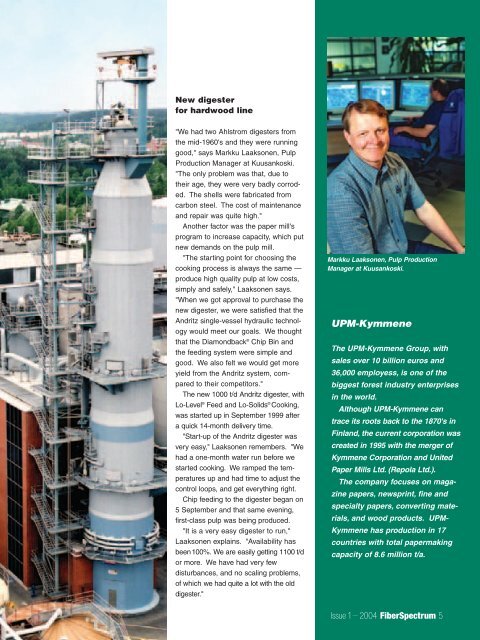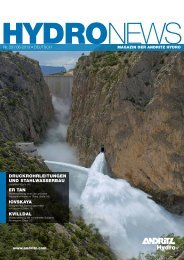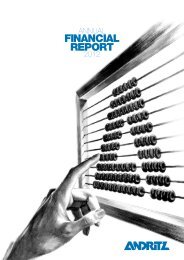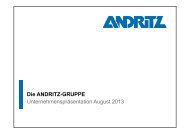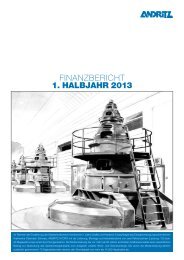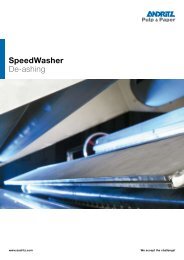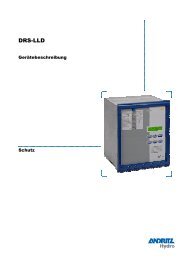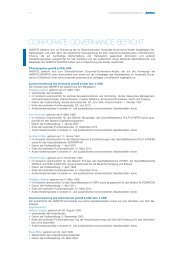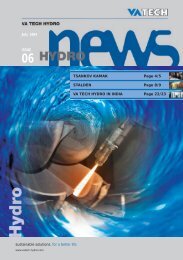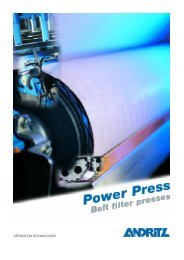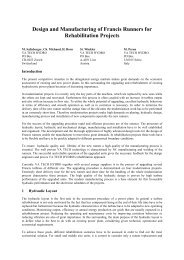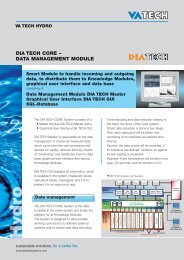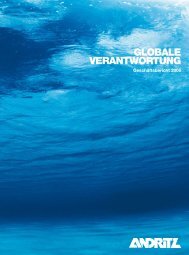The customer magazine of Andritz Pulp & Paper Issue 1— 2004
The customer magazine of Andritz Pulp & Paper Issue 1— 2004
The customer magazine of Andritz Pulp & Paper Issue 1— 2004
Create successful ePaper yourself
Turn your PDF publications into a flip-book with our unique Google optimized e-Paper software.
New digester<br />
for hardwood line<br />
"We had two Ahlstrom digesters from<br />
the mid-1960's and they were running<br />
good," says Markku Laaksonen, <strong>Pulp</strong><br />
Production Manager at Kuusankoski.<br />
"<strong>The</strong> only problem was that, due to<br />
their age, they were very badly corroded.<br />
<strong>The</strong> shells were fabricated from<br />
carbon steel. <strong>The</strong> cost <strong>of</strong> maintenance<br />
and repair was quite high."<br />
Another factor was the paper mill's<br />
program to increase capacity, which put<br />
new demands on the pulp mill.<br />
"<strong>The</strong> starting point for choosing the<br />
cooking process is always the same —<br />
produce high quality pulp at low costs,<br />
simply and safely," Laaksonen says.<br />
"When we got approval to purchase the<br />
new digester, we were satisfied that the<br />
<strong>Andritz</strong> single-vessel hydraulic technology<br />
would meet our goals. We thought<br />
that the Diamondback ® Chip Bin and<br />
the feeding system were simple and<br />
good. We also felt we would get more<br />
yield from the <strong>Andritz</strong> system, compared<br />
to their competitors."<br />
<strong>The</strong> new 1000 t/d <strong>Andritz</strong> digester, with<br />
Lo-Level ® Feed and Lo-Solids ® Cooking,<br />
was started up in September 1999 after<br />
a quick 14-month delivery time.<br />
"Start-up <strong>of</strong> the <strong>Andritz</strong> digester was<br />
very easy," Laaksonen remembers. "We<br />
had a one-month water run before we<br />
started cooking. We ramped the temperatures<br />
up and had time to adjust the<br />
control loops, and get everything right.<br />
Chip feeding to the digester began on<br />
5 September and that same evening,<br />
first-class pulp was being produced.<br />
"It is a very easy digester to run,"<br />
Laaksonen explains. "Availability has<br />
been100%. We are easily getting 1100 t/d<br />
or more. We have had very few<br />
disturbances, and no scaling problems,<br />
<strong>of</strong> which we had quite a lot with the old<br />
digester."<br />
Markku Laaksonen, <strong>Pulp</strong> Production<br />
Manager at Kuusankoski.<br />
UPM-Kymmene<br />
<strong>The</strong> UPM-Kymmene Group, with<br />
sales over 10 billion euros and<br />
36,000 employess, is one <strong>of</strong> the<br />
biggest forest industry enterprises<br />
in the world.<br />
Although UPM-Kymmene can<br />
trace its roots back to the 1870's in<br />
Finland, the current corporation was<br />
created in 1995 with the merger <strong>of</strong><br />
Kymmene Corporation and United<br />
<strong>Paper</strong> Mills Ltd. (Repola Ltd.).<br />
<strong>The</strong> company focuses on maga-<br />
zine papers, newsprint, fine and<br />
specialty papers, converting mate-<br />
rials, and wood products. UPM-<br />
Kymmene has production in 17<br />
countries with total papermaking<br />
capacity <strong>of</strong> 8.6 million t/a.<br />
<strong>Issue</strong> 1 — <strong>2004</strong> FiberSpectrum 5


